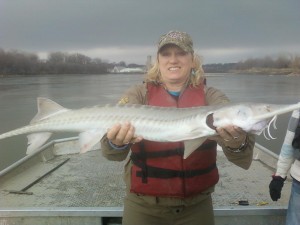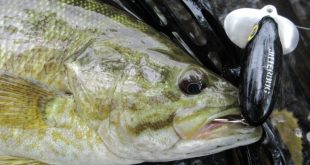
Gear packed and loaded into our vehicles, we left the office around 7:30 a.m. on our way to Nebraska City to hitch up the boats and set our sights on the Missouri River. The temperature was 64 degrees at 10 a.m., but the weather forecasts promised plunging temperatures and rain for our journey. Most of the team was more than familiar with the fickle Nebraska spring weather and we had come dressed for whatever the day might bring. I had joined Thad Huenemann-Fisheries Biologist, Adam Kendall- Conservation Technician, along with Frank Albrecht- NGPC Environmental Science. Frank had brought along his 3 sons; Grant, Easton & Mitchell (9, 11 & 13 yrs old), who had worked on these broodstock studies for the last three years and pretty much had the details down. I was a bit nervous, being the new kid on the boat so to speak.

One of the first “hands-on” assignment we were tasked with was pulling trot lines. These lines consisted of ropes 210 feet long with 40 hooks about every five feet on the line. Orange floats were attached on either end with an anchor on one side and a small concrete square on the other. I soon learned there was a real system to this task. Here’s how the retrieval of the line worked. Adam and Frank stood on the hull at the front of the boat. While Adam pulled in the lines, Frank would pull off the clips (hook and string) and hand them to the boys who promptly placed them on boards. If the hook had a fish on it then Frank handed it to me. My anticipation was really high and my adrenaline pumping as I watched them pull in the first line. I had no idea what to expect. The first fish we pulled off was a shovel-nosed sturgeon. I was pretty amazed looking at it; I had never seen one up close and was really intrigued to see what their mouths actually looked like up close; talk about pre-historic!
 Every fish we caught was placed into a holding tank of water. After we pulled each line the fish were measured, weighed, examined and released. Many of the shovelnose we caught that day had tags on them from previous studies. Catfish, drums and common carp were all part of the routine that day, hooked, unhooked, examined and documented.
Every fish we caught was placed into a holding tank of water. After we pulled each line the fish were measured, weighed, examined and released. Many of the shovelnose we caught that day had tags on them from previous studies. Catfish, drums and common carp were all part of the routine that day, hooked, unhooked, examined and documented.
But the elusive Pallid Sturgeon was what we were really hoping to pull in from our lines. Pallid Sturgeons are listed as an endangered species and come from the age of dinosaurs, nearly 70 million years ago. NGPC’s fisheries division conducts these studies each year to collect the pallid before spawning season. Any pallid caught are then sent to a hatchery to be used for broodstock. During our entire time on the river our crew only caught one Pallid Sturgeon that entire day. But the pallid we did pull in was a beauty. It was very large and had a tracking tag already attached. One of the team members, Thad, took a fin clip sample which would help them later determine the fish’s original location. From these tests they can also find out if it is a wild fish or a fish that was raised in a hatchery. A wild pallid sturgeon is very rare find indeed.
After lunch the entire crew put fingers to worms on 400 hooks! The lines were put back into the water so the next day’s crew could replay the routine all over again. The experience is one I will never forget and I learned a lot from the Game and Parks Pallid Sturgeon team. Even though the temperature dropped 20 degrees and it started raining it was a great learning experience for this instructor and one I won’t soon forget. Seeing that fish up close and getting to hold him up for the camera was a first for me. Thanks to everyone involved for sharing your work experience with me and letting me help and for teaching me something new! Here’s a few more photos of the team doing their thing.
 Nebraskaland Magazine
Nebraskaland Magazine



